Fly or drive? The answer is, it depends
In early December a friend from Denver and I both traveled to Las Vegas for a conference. I flew, he drove. We both worry about greenhouse gases accumulating in the atmosphere and the strong evidence now emerging of climate disruption. Which of us should have more carbon guilt?
Flying shame, the phrase translated from its native Swedish, has come into vogue, at least in some circles. We zoom around the continent, sometimes across great oceans, because we can, and because it’s wonderful compressing great distances with so little effort, so quickly immersing ourselves in new geographies and cultures, and because, as was the case of my friend and I, we thought our work required it.
Quick and easy movement has a cost, though.
If emissions from airplanes were a country, they would rank somewhere between Japan and Germany. That means about 1.5% of global emissions (carbon dioxide equivalent) as of 2012, according to the World GHG Emissions Flow Chart 2014. Other sources, slicing the greenhouse gas pie differently, put it at 2.4%. Residential buildings (11.2%), cars and trucks (10.6%) or even livestock and manure (6.5%) produce more.
Scientists, however, suspect impacts may actually be double or more those at ground level because of the chemical interactions of emissions at high altitudes. Uncertainty remains about how contrails produced by airplanes may force radiative heating.
Emissions have been growing. “‘Worse Than Anyone Expected’: Air Travel Emissions Vastly Outpace Predictions,” the New York Times reported in October. Growth in air travel, it explained, has dramatically outpaced gains in efficiency.
High-income countries and upper-middle income countries have been responsible for 90% of emissions. The U.S. alone is responsible for 24% of emissions. Less-developed countries that contain half the world’s population accounted for only 10% of all passenger transport-related aviation CO2.
In the U.S., 12% of the population take 66% of flights.
“Although huge homes and hulking SUVs are familiar symbols of emissions excess, frequent flyers are among the people with the very biggest carbon footprints,” says Robert Henson in “The Thinking Person’s Guide to Climate Change.”
Just 6% of the world’s population has ever flown.
The International Air Transport Association projects that global air travel will reach 8.2 billion annual passenger trips by 2040, up from 1.8 billion in 2000. A large part of that story will be China, India and other countries as they produce larger middle classes able to afford air travel. Aircraft might account for 25% of the global carbon budget by 2050 as emissions from other sectors phase out combustion of fossil fuels, according to a 2019 report from United Nations International Civil Aviation Organization projects.
Success of ski and other resorts during the last 60 years has been tethered tightly to wings of airplanes. Ease of flight has been so important in attracting customers that many ski resorts have offered subsidies to airlines or at least income guarantees.
This poses a conundrum. Snow sliders more than most embrace environmental values, not least the joys of snow. Greenhouse gases pose a direct and almost immediate threat to snow. How can we harm that which we treasure? What is our responsibility?
Technology solutions remain distant. Climatic disruptions look more imminent.
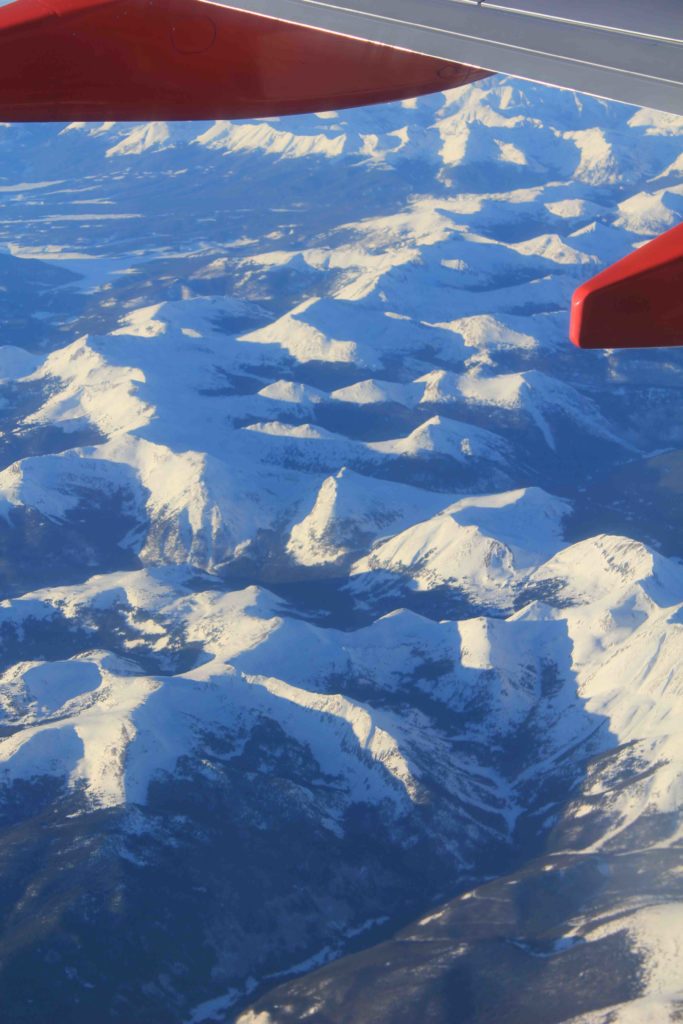
A plane flying across the Sawatch Range in Colorado in the approximate location of Monarch Pass in February 2017 showed the string of 14,000-foot peaks commonly called the Collegiate Peaks to the north. Photo/Allen Best
The climate emergency
Weather warms and cools naturally, with “very strong inter-annual and decadal variability,” as a 2019 report by the International Panel on Climate Change noted. But clear human fingerprints have become evident.
NASA and the National Oceanic and Atmospheric Administration reported in January that 2019 was second hottest on record, trailing only 2016. The past five years each rank among the five hottest since record-keeping began. And 19 of the hottest 20 years have occurred during the past two decades.
Human fingerprints have also been detected in weather extremes. Consider the wildfires in Australia that in just a few days in early January covered areas the size of Switzerland. As New York Times columnist Paul Krugman notes, “climate change makes the kinds of extreme weather events we’ve been seeing much more likely.”
If winter can still bring tremendous dumps of snow, the edges have begun fraying discernibly, most notably during spring. But even mid-winter can have eerie warm spells. Vail and Aspen both had significant January rainstorms several years ago. Other resorts, including Whistler, lower in elevation and near the Pacific Ocean, have always had rain, but now expect to see rain become more common and occur higher up the slopes.
Scientists have stipulated we must keep warming within 2 degrees Celsius or risk serious threat of destabilization. Better would be 1.5 degrees. Temperatures have already climbed about 1 degree globally, less in some places but more in others. Even if emissions were to stop tomorrow, the heat to be produced from existing atmospheric pollutants will likely increase temperatures another 0.5-degree globally.
Why the fuss about 1 or 2 degrees Celsius? A little change can have outsized impact. Consider that it took just drops of 1 or 2 degrees to plunge the Earth into the Little Ice Age, permitting Queen Elizabeth to routinely play ice games during the 16th century on a frozen Thames River. But then there were the big Ice Ages, when glaciers marched southward across North America. The last glacial advance put parts of Canada under ice of up to 4 kilometers and extended southward across Wisconsin and other border states. It was accompanied by a 5-degree average drop.
Change may be neither uniform nor linear. The IPCC’s 2019 special report noted that the American South has warmed very little. But Alaska and western Canada among other places with higher elevations and northerly latitudes that have had increases of 5 degrees Celsius (9 degrees Fahrenheit) since the 1950s. The Washington Post’s Juliet Eilperin in December told about cemeteries in coastal towns of Alaska being submerged by water as the earth melts.
Worries about feedback loops
Scientists fret about feedback loops. For example, there’s the albedo effect. White reflects sunlight, but dark materials absorb it. This has been demonstrated in Colorado’s San Juan Mountains. There, storms have delivered dust from the drying and disturbed deserts of the American Southwest on the snowfields above Telluride, Silverton, and other mountain towns. The dark-colored dust causes the snow to melt more rapidly. Now consider what happens as glaciers recede and Arctic sea ice is replaced by dark-colored sea water.
Worrisome to many has been the accelerating retreat of the Greenland ice sheet. A 2019 article in Nature, a scientific journal, reports that the massive ice sheet could be doomed at 1.5 degrees, which could happen as soon as 2030.
Methane released as the polar permafrost warms would be another feedback loop. This greenhouse gas disappears from the atmosphere for less than a decade while carbon dioxide lingers for hundreds and even thousands of years. It has powerful heat-trapping properties during that short time, though, 86 times as effective than carbon dioxide over a 20-year period. Henson, in “Climate Change,” cites the IPCC report of 2014 in concluding that methane releases from a warming Arctic are not expected to become a major issue for some time, “although the longer-term risks are sobering indeed.”
To stay within that margin we must quickly and dramatically cut back emissions. Instead, we’re accelerating like a driver heading into a tight curve.
During the Industrial Revolution, as factories in England billowed with coal fires, concentrations of carbon dioxide, the most common greenhouse gas, stood at 280 parts per million. When climate scientist James Hansen famously testified before the Senate committee in 1988, they had reached 350 ppm. This year they can be expected to near 420 ppm. Human-caused emissions have more than doubled in only three decades. Unless we have drastic changes, babies being born this year can expect, when entering college or trade school, to have global concentrations of 450 ppm.
In 2003, when I began studying climate change reports, scientists were warning about greater risks of climate destabilizing at 450 ppm. Since then I’ve observed that scientists, for the most part, have tended toward conservatism. The reality has had faster feet.
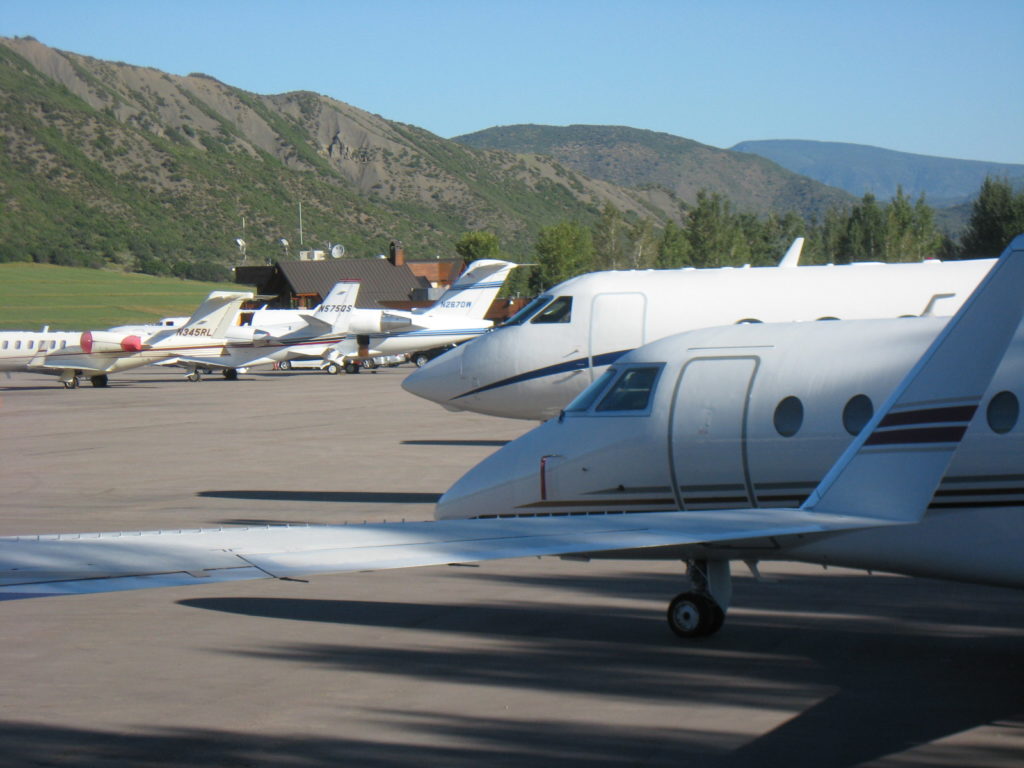
Private jets crowded the perimeters of the Aspen/Pitkin County Airport in the summer of 2010. Mountain resorts have been highly reliant upon air travel for delivery of customers. Photo/Allen Best
Perhaps the Swedes were unnerved by their fires above the Arctic Circle. In 2015, Olympic biathlon gold medalist Bjørn Ferry committed to stop flying. Some Swedish celebrities have followed suit. To avoid flying, the adolescent climate activist Greta Thunberg last summer sailed to the United States to call for urgent action. She has a following, as was acknowledged by Time Magazine with its Person of the Year designation, displacing a churlish Donald Trump. It’s fair to assume that some snow riders, with their devotion to environmental action, follow the sometimes dour but always precocious Swedish lass.
Most carbon-efficient travel
What’s the least carbon-tainted mode of travel to a mountain resort? Bicycle, obviously, although catching a bus will do you well, too. It’s a bit cumbersome, definitely more time-consuming, but you can take a bus from Chicago, for example to Glenwood Springs, then catch a RFTA bus to Aspen or Snowmass. The state-sponsored Bustang from Denver to Glenwood Springs has won raves. But again, don’t be in a hurry.
Few people ride the rails to go skiing. At Colorado’s Winter Park, for example, rails emerge from a tunnel under the Continental Divide within a few dozen yards of ski slopes, but Amtrak delivers just 10,152 travelers to the nearby depot in Fraser annually. A ski train from Denver adds 20,000 passengers annually for day trips.
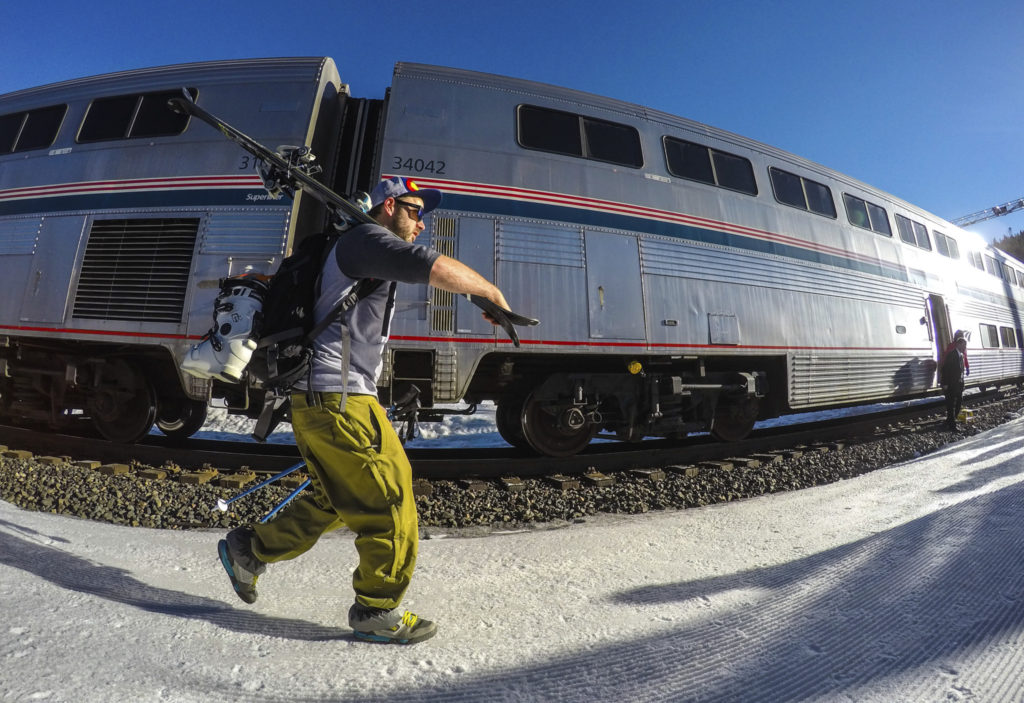
Amtrak delivers passengers to Fraser, within four miles of the slopes of Winter Park Resort. Photo/Winter Park Resort
We fly, because we’re in a hurry. Air travel has become more efficient in jet fuel. By the metric of passenger travel achieved on a gallon of jet fuel, air travel has improved from 34 passenger miles per gallon in 1991 to 56 passenger miles today.
Not all air travel is equal, though. You can bet that Air Force One, the jet used to ferry U.S. presidents around the globe, with its executive desk and sleeping quarters, has a higher carbon footprint than somebody flying scrunched between other passengers, barely able to breath. And first-class commercial travel has three times the carbon footprint of economy.
How far you fly also matters. Shorter flights have a greater carbon intensity per mile than long-haul flights. A quarter of the fuel on a single trip can be burned in getting from the ground to 30,000 feet. That makes short-hop flights, say between Denver and Aspen, the most energy intensive.
This rule only applies so far, though. The fuel itself for very long-haul flights requires energy for transport, because of its weight. WorldWatch Institute estimates that the most fuel-efficient distance for airlines is 2,600 miles, a little longer than the trip from New York to Los Angeles. But those added miles still produce more fuel consumption and hence emissions. Shorter, if less efficient, is still less.
What does this mean in practice? The carbon-tracker website maintained by the International Civil Aviation Organization allows you to calculate your carbon dioxide emissions. For example, an economy round-trip flight between New York City’s JFK Airport and Denver produces 946 pounds (of carbon per passenger. That’s the equivalent of 59 bowling balls. Talk about carry-on baggage. A longer distance produces a fatter footprint as does flying premium instead of economy: 3,934 pounds. OK, you wanted to know: 246 bowling balls.
Can you really offset your travel?
What makes environmental sense—and economic sense for ski areas—is that when customers fly, they linger. A study of Rocky Mountain resorts by Colorado-based RRC that was commissioned by the National Ski Areas Association found 40% of out-of-state customers who flew stayed six days or longer. Of international travelers, 80% stayed six days or longer. The difference was particularly evident among those who stayed between 10 and 22 nights at the resorts.
“As would be expected, international visitors tend to have the longest stays, followed by out-of-state visitors (and then) in-state visitors,” says RRC’s David Becher.
Driving, in some situations, could be worse than flying. It depends upon the vehicle and the number of occupants. Driving solo from Chicago to Denver in a SUV, for example, will be more carbon intensive than flying economy. But number of occupants, distance, and plushness of the jet make this less than straightforward. The best guide to travel comparisons I found was assembled by the Union of Concerned Scientists. (See chart).
For the water conference in Las Vegas, my friend from Denver rented a medium-sized electric hybrid that gets 40 mpg and drove alone. I flew first to Reno then Las Vegas. A woman sat next to me, her hair dreaded fashionably and dyed blond at the ends, her perfume so powerful I nearly gasped as we flew over the slopes of Park City. My return to Denver was direct.
Who should have less carbon guilt? My research on the carbon-tracker website suggests I was responsible for 240 pounds (109.1 kg) of carbon emissions compared to 334 pounds (151.5 kg) for my friend in his rented hybrid car. Had my friend and I gone together by car, we would have had much lower carbon footprints. But we didn’t know of each other’s plans. Plus, the day he had set out from Denver by car, I had been in Florida in the interest of familial piety. It gets complicated.
My friend does buy carbon offsets when traveling, whether by car or by plane. Such offsets have become more common. Air travelers flying in and out of two mountain resort communities are now participating in an offset program called Good Traveler. Good Traveler was initiated in 2016 by the San Diego International Airport, which chose the Basalt-based Rocky Mountain Institute to manage it. It now has 17 U.S. airports. Including major hubs in San Francisco and New York City. The Aspen/Pitkin County Airport joined the Good Traveler program in 2020.
Flying roundtrip between New York’s La Guardia Airport will nick you $8. Money collected in New York goes to improve marine efficiency in the harbor there. This and other qualifying offsets must demonstrate actions that can be verified and measured. Would this action have occurred or been avoided had the money not been invested?
In Wyoming, the Jackson Hole Airport also offers offset money. That money goes to ensure that the native prairie at the May Ranch in southeastern Colorado remains unplowed, continuing to sequester carbon. Telluride’s Pinhead Climate Institute has also purchased offsets for all its festival-goers at Telluride Bluegrass, with that money also going to the prairie preservation.
If offsets allow us to feel better about our travel, some analysts have been skeptical. We need actual reductions of emissions, not just offsets, they say.
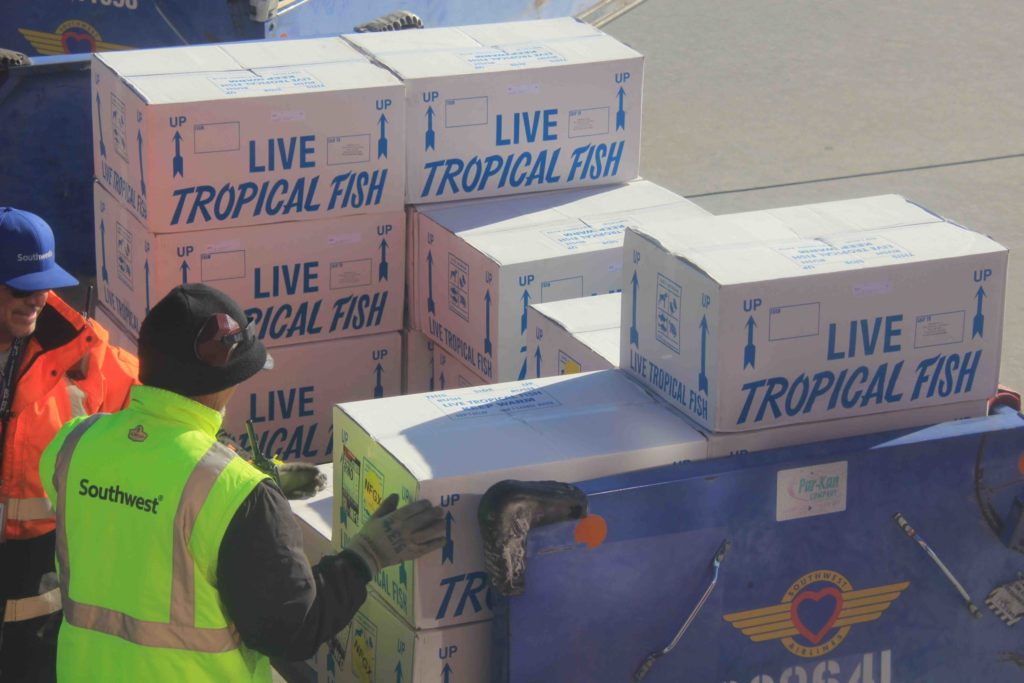
Airport workers load boxes of tropical fish for a flight from Reno to Las Vegas in December 2019. In our era, even fish can fly. Photo/Allen Best
Burning biofuels, instead of fossil fuels, would theoretically reduce emissions. But they have been unable to achieve scale. In 2018, just 2 million liters of alternative jet fuel were produced, compared to the 360 billion liters of jet fuel consumed that year. (Note the “m” and the “b.”) Too, some suspect that lifecycle carbon costs of biofuels make them little better than conventional fossil fuels.
Electric planes?
Electrification of planes has produced excitement of late. All-electric planes began use in 2019 at a Denver-area airport for training of pilots. In December, a Vancouver company attracted international attention when it conducted a 10-minute demonstration flight of a 17-passenger seaplane retrofitted to operate on batteries. Harbour Air hopes to begin commercial operations within two years after safety of the e-planes has been proven. It plans an eventual fleet of 40 e-planes for short hops along the Pacific Coast in the Seattle-Vancouver area.
Ampaire, another company has made slower-moving, short-range and smaller aircraft such as are used to shuttle passengers among the Hawaiian Islands its goal. Peter Savagian, the company’s senior vice president of engineering, told an audience in Aspen during November that such short-haul flights were responsible for one-third of global air emissions. NASA awarded Ampaire and another company, IKHANA, contracts to pioneer hybrid diesel/electric configurations for the 19-passenger Twin Otter.
Advances in battery storage will be needed for longer distances. Battery storage has improved. A Tesla 3 battery has 10 times as much energy density as that used in the EV 1, an early electric vehicle that went into production in 1996 when Savagian was with General Motors. Energy from batteries has been increasing 8% annually.
But much, much more will be needed. Even the newest batteries hold just 2% that of liquid fuel, Wired magazine explained in a 2017 story. In other words, 1,000 pounds of jet fuel yields about 14 times more energy than a 1,000-pound battery.
In his talk at an Aspen Institute symposium titled “The Future of Aviation in a Carbon Constrained World,” Savagian counseled patience.
“It will be decades before the largest aircraft are likely to be fully electrified,” he said. But when that happens, both airlines and consumers will benefit, he added. His company projects savings of 90% from electrified airplanes and maintenance costs cut 50%. Those savings, in turn, will allow airlines to cut fares by 15%, producing 40% more volume.
Use other components
Speaking at the same event, Aspen-area resident Amory Lovins—a co-founder of the Rocky Mountain Institute—maintained that airplane manufacturers could use carbon-fiber composite materials to make airplanes three to five times more energy efficient. “Many components made of metal today should not be,” Lovins said. He cited a simple $20 coffee pot. Replaced by a higher-tech model with energy consumption it saves weight and hence fuel. “You take a pound out of a typical airplane and it’s worth around $2,000 in net-present value in fuel costs.”
Lovins has credentials. In 1976, amid the Arab oil embargoes, he wrote a landmark essay published in Foreign Affairs magazines that talked about climate change, renewable energy and energy efficiency. Both businesses and governments responded to his vision sluggishly. Time has mostly proven him correct.
Price signals are needed to spur airlines to more rapid adoption of fuel-saving technology.
“Without a clear market signal, vendors and investors will largely stay on the sidelines,” Lovins said. He deplored incrementalism that squanders fuel, efficiency and precious time.
“The climate crisis will not wait,” he insisted. “Business as usual won’t work.”
Some think we’re in such a climatic pickle that we need to explore high-risk geo-engineering strategies.
For example, can temperature rise of accumulated greenhouse gases be counteracted by reflecting more sunlight away from the Earth’s surface with giant mirrors in space? Another idea calls for spraying aerosols into the stratosphere, which is about 10 kilometers above the Earth’s surface, simulating the effect of volcanic eruptions. A volcano eruption in the Philippines in 1991 cooled global temperature by 0.6 degrees Celsius for about two years.
Direct air capture is another idea, part of a broader set of solutions called negative emissions technology. This idea seeks to withdraw carbon dioxide or other greenhouse pollutants from the atmosphere. This is already being done in British Columbia by a company called Carbon Engineering. The company was founded in 2009 by David Keith, then a professor at the University of Calgary (and now at Harvard University). Keith, with backing from Bill Gates and Murray Edwards, a financier of oil/tar sands extradition in Alberta (and co-owner of the Calgary Flames), succeeded in removing CO2 from the atmosphere in 2015 and converting it into fuel in 2017 at the prototype between Vancouver and Whistler. Now, with backing from oil producers Chevron, Occidental and BHP, he’s trying to accomplish this at scale.
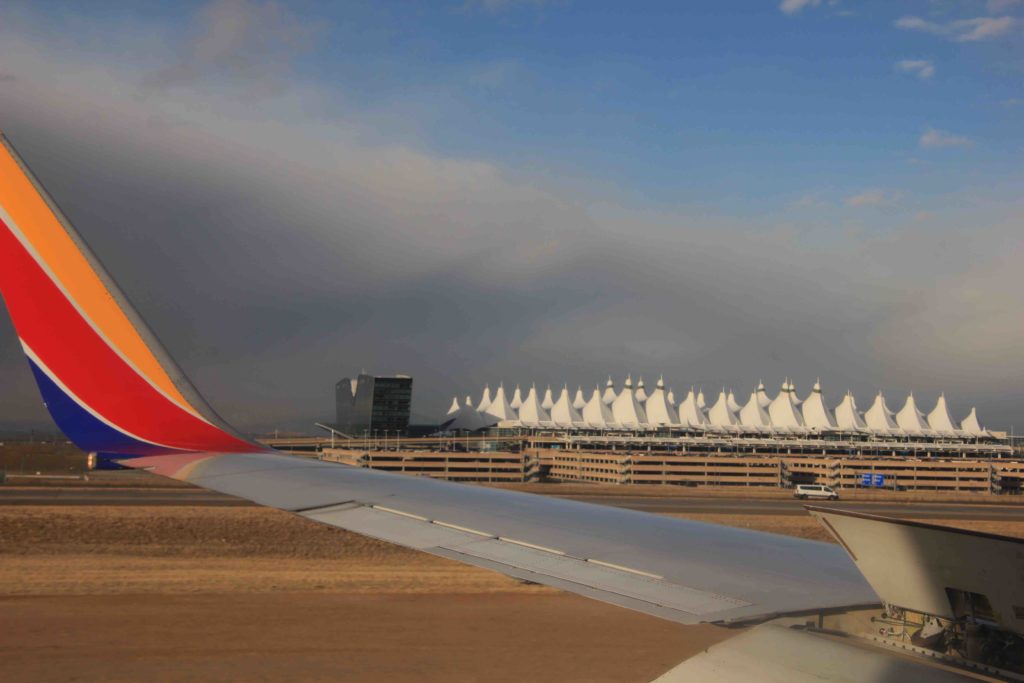
A Southwest Airlines jet flies into Denver International Airport in 2019. Southwest planned expansion of its traffic in and out of DIA. Photo/Allen Best
But Keith, in a 2013 book called “A Case for Climate Engineering,” warned against seeing geo-engineering as the solution to climate change. “Our gadget-obsessed culture is all too easily drawn to a shiny new tech fix,” he said. Best, he said, would be to avoid creating emissions.
In Colorado, upgrades are planned for the Aspen/Pitkin County Airport. The Pitkin County commissioners early identified “carbon emission reduction” as a core community value that needs to be applied to the new facility. It will not, however, produce any fewer emissions of the flights.
In aviation, as in so much else, it’s easier to create the problem than solutions.
A case in point is Denver International Airport, the fifth busiest airport in the United States and a hub for many connecting flights to Aspen and other ski towns. The airport plans to add 39 new gates to accommodate growing traffic. Nowhere in the stories announcing the expanding airlines was mention of the carbon footprint.
This story was published in the Feb. 11 issue of Big Pivots. It was also published in various iterations in Ski Area Management magazine, Pique Newsmagazine of Whistler, B.C., and the Aspen Times Weekly.
Why support Big Pivots?
You need and value solid climate change reporting, and also the energy & water transitions in Colorado. Because you know that strong research underlies solid journalism, and research times take.
Plus, you want to help small media, and Big Pivots is a 501(c)3 non-profit.
Big grants would be great, but they’re rare for small media. To survive, Big Pivots needs your support. Think about how big pivots occur. They start at the grassroots. That’s why you should support Big Pivots. Because Big Pivots has influence in Colorado, and Colorado matters in the national conversation.
- A big charge for Colorado’sEVnetwork - April 13, 2024
- United Power to get solar from near Pawnee - April 10, 2024
- Today’s shift to EVs and a long-ago motorcycle ride - April 10, 2024





